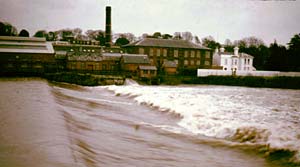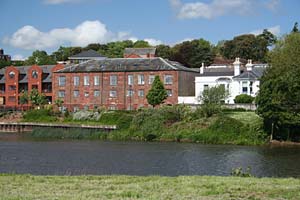
Trews Weir
Page updated 12 February 2009
In 1564-6 John Trew of Glamorgan cut a 1¾ mile channel which became the Exeter ship canal, the first such, in England. The canal was only 16ft wide and 3ft deep but it made it possible for barges to bypass the shallow and unreliable river. The old St Leonard's Weir was replaced by Trews Weir to raise the river to feed the canal. The weir was used to provide water for a fulling mill, a cotton mill and a paper mill.
The weir was often the site of drownings, as attempts to walk across the spill were made, and the victim swept in, or boats dragged over the weir with the subsequent loss of life. The Welcome Inn was often used for inquests of those drowned at Trews Weir.
In January 1881 there was a great snowstorm and the Exe froze solid. When it began to thaw, the water rose and broken pack ice, from up river, jammed under the Exe Bridge. A large crowd gathered to watch the Council workers break the ice below the bridge and thus release the log jam ice pressing against the bridge. Suddenly it was free and a huge mass of ice flowed down the river. The crowd ran along the bank to Trews Weir to see what would happen. The Flying Post wrote "A vast body of water was flowing over the weir, and most of the ice, when it reached the crest, was dashed over into the surge, breaking and crumbling as it fell."
When the City Council, in 1899, was deciding on a new electricity generating station to replace the one in New North Road, they considered a hydro-electric scheme at Trews Weir. In the event, they built the electricity generating station at Haven Banks.
For a couple of weeks at the beginning of February 2008, the sluice gate at Trews Weir was opened to drain the river between Blackaller and Trews Weir. The banks of the river were exposed for the first time for almost forty years revealing shopping trolleys, bicycles and other rubbish. The outlet from the Chutebrook at the bottom of Colleton Hill was seen for the first time for many years, while flocks of gulls took advantage of the mud flats to feed.
 Trews Weir in flood
and the Trews Weir
paper mill. Courtesy Alan H
Mazonowicz
Trews Weir in flood
and the Trews Weir
paper mill. Courtesy Alan H
Mazonowicz  The redbrick building and the white
house are all that remain of the paper mill.
The redbrick building and the white
house are all that remain of the paper mill.
│ Top of Page │